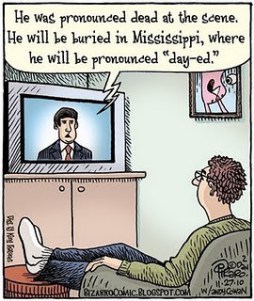Phillip T. Stephens's Blog: Wind Eggs, page 8
July 6, 2017
Distinguish Your Characters With Dialect
Before you jump to Jan R’s post on learning to distinguish characters with dialogue, let me precaution you:
characters by adding dialect. However, good dialect is difficult to write.1
Even well-written dialect can distract from the flow of the story. When I use it, I highlight one or two key mannerisms (“you all” or “you guys” instead of you. Only in extreme circumstances would I use “y’all” or “youse guys.”) When your readers have to slow down to process complex dialect, you’ve exchanged indistinguishable characters for awkward, plodding prose.
The same goes for creating world vocabularies. The Dune series worked the motif to death by the last book. The world’s moved on. Yes, there are readers that expect fifty glossary pages at the end of the book. Those readers rarely stray from formula fiction, Many readers hate wading through ponderous prose forcing us to turn to the back. It’s one of the first reasons we pass on to the next book.That being said, once you finish your first draft, it’s time to look at your dialogue. If all your characters sound the same, readers find it difficult to follow the novel.
Jan R shares her experiences learning to write distinguishable character dialogue.
For instance, one first time writer slaved to write jive turkey dialect for the only black character in his novel. I pointed out that his character was Harvard educated and wouldn’t be caught dead talking like a character from a blacksploitation film (not to mention the questionable judgment of having the only black character both jive-talking and Harvard educated). Rather than rewriting the dialogue, he chose to insert a line where his character said he “talked jive to fuck with the man.” Some readers may buy it. If they never finished high school.back
 Writing your first novel-Things you should know
Writing your first novel-Things you should know
 Do your characters have their own voice or do they sound the same? I had a critique partner tell me that she couldn’t distinguish characters in my manuscript based on dialogue. They all sounded the same. If I hadn’t provided a dialogue tag, she would have had no idea which character was speaking. She was right.
Do your characters have their own voice or do they sound the same? I had a critique partner tell me that she couldn’t distinguish characters in my manuscript based on dialogue. They all sounded the same. If I hadn’t provided a dialogue tag, she would have had no idea which character was speaking. She was right.
This was something I definitely had to correct. So I did some research, watched a webinar, and took a class on dialogue. Distinguishing between characters is a lot easier than you would think.
One way to differentiate characters and determine who they are is through dialect. We can learn a lot about a person based on their accent, grammar, and choice of words.
You don’t have to ask a person if they are from the North or South-just listen to how they speak and note their word choices. While this is one of the most obvious examples for me, you…
View original post 258 more words


June 29, 2017
Toast
Asymmetrical arrangement of toast on platter.
" data-medium-file="https://ptstephensdotcom.files.wordpress.com/2017/06/toast.jpg?w=300&h=179" data-large-file="https://ptstephensdotcom.files.wordpress.com/2017/06/toast.jpg?w=800" class="size-medium wp-image-2198" src="https://ptstephensdotcom.files.wordpress.com/2017/06/toast.jpg?w=300&h=179" alt="toast platter" width="300" height="179" srcset="https://ptstephensdotcom.files.wordpress.com/2017/06/toast.jpg?w=300&h=179 300w, https://ptstephensdotcom.files.wordpress.com/2017/06/toast.jpg?w=600&h=358 600w, https://ptstephensdotcom.files.wordpress.com/2017/06/toast.jpg?w=150&h=90 150w" sizes="(max-width: 300px) 100vw, 300px" />
Festive toast platter courtesy of Jennifer Pallian at unsplash.com (may be cookies, but close enough).
Needs butter. Real butter not margarine or low cal squeeze from a bottle crap that dribbles out like puss from a wound but churned by hand from the milk of grass-fed, free range contented virgin cows, put to bed each night with stories and Bach. Oven baked. 350°. Fifteen minutes.
Shout out to Sacha Black 52 Words Week 26


Need to brush up your HTML?
Why would you need to know HTML 5, you might ask? I’m a writer. Others, like me, know how useful HTML and CSS are to customizing our WordPress templates or working around the many WordPress limitations. I’m always switching to the text window to enter code. My banner at the bottom of this page was added using code.
[image error]
Coding is a little less difficult with a handy cheat sheet. (Image courtesy of Inspirationfeed.)
I stumbled across this handy HTML5 cheat sheet and thought I’d share it. I was surprised at the number of useful tags I hadn’t picked up on yet. Even if you don’t use HTML yet, hang on to the bookmark. You never know when you’ll need it.
Book Reviews
check out my books at Amazon.com


June 24, 2017
The Trouble with Writing Endings
Kristen Twardowski discusses the problem many writers face—deciding when to end your story. Tolkien, for instance, had such a difficulty ending the Lord of the Rings that the last half of The Return of the King is an almost excruciating account of Bilbo’s return home, and more, and even more. Peter Jackson, thinking the movie should follow suit, makes viewers sit through almost half an hour of bed jumping and superflous weddings.
Here’s my rule of thumb: Every story/novel should follow a basic arc. The set up prepares readers for the climactic moment of the story, the moment without which the story falls apart. The set up should comprise the bulk of the story. The climax ties the central threads of the story into a single event (or moment). The cigarette (denouement, falling action) recounts the fallout from the climax. It shouldn’t introduce new story elements or turn the page to an entirely new chapter of the story. If your cigarette is longer than your setup, you will leave your reader’s unsatisfied. Oh, and by the way, the cigarette is for them not for you,
My point is, as long as you remember what the three elements do, you will find it easier to bring your story to an end.
Ask yourself if what you want to include, sets up the climax, is an element of the climax or is a direct consequence of one of the two. If you can’t answer yes to at least one of those questions, leave it out no matter how much you want to include it.
Your story’s over.
Put it to bed.
1However, under no circumstances should your reveal be “they were dreaming the whole time,” or “they’re dead” (Matthew Fox and the writers for Lost). It’s cheap, lazy and the sure sign of a rank novice.back
 Paul Gauguin, “Portrait of a Young Woman. Vaite (Jeanne) Goupil),” Ordrupgaard, via Wikimedia. The trouble with writing endings is that endings don’t actually exist. Not really. Instead there simply comes a moment when we stop telling the story.
Paul Gauguin, “Portrait of a Young Woman. Vaite (Jeanne) Goupil),” Ordrupgaard, via Wikimedia. The trouble with writing endings is that endings don’t actually exist. Not really. Instead there simply comes a moment when we stop telling the story.
Knowing when to stop has always been hard for me. In my head, I can’t help but carry the narrative on. What happens to the hero after she defeats the evil king? What happens after the protagonist gets married? What happens to the soldiers who were part of the losing army? What happens to the rest of the universe when the brightest star in a galaxy explodes?
There is always an after. And an after the after. And another after after that.
But the writer still has to stop telling the story at some point.
Where we decide to place the ending changes the meaning of a narrative. Does the tale…
View original post 98 more words


June 22, 2017
700 Free Art Books from the Guggenheim and Metropolitan Museum of Art
Kristen Twardowski shares a great resource for readers and authors: Free Art books.
Art? you say. Why do I need art? Check these books out to see what you missed with that attitude.
 Stevenuccia, “Interno Guggenheim,” Solomon R. Guggenheim Museum, New York, July 30, 2012, via Wikimedia.
Stevenuccia, “Interno Guggenheim,” Solomon R. Guggenheim Museum, New York, July 30, 2012, via Wikimedia.
I’m an art nerd. If you ever want to see me get stupidly excited, start a conversation about Japanese prints or Near Eastern archaeology. Unfortunately for me, finding great books about art can be difficult.
Oh, the books exist. Museum gift shops and college libraries are full of them after all. But they also tend to be hideously expensive. Those glossy images and thick pages add up, and my bank account whimpers every time it sees the prices for them. Luckily the Guggenheim and the Metropolitan Museum of Art have both begun to make art related books freely available.
The Guggenheim’s digital archive currently contains 204 books on Lichtenstein, Picasso, Kandinsky, and others. The Met has made a somewhat larger collection available; you can read any of 502 books from their MetPublications digital collection online…
View original post 106 more words


June 19, 2017
Write Like You Tweet?
“I’ve long believed working with Tweets forces me to become a more clear and concise writer. For more than a year I tweeted three to four tweet stories almost nightly. How can we reduce an entire story to two or three sentences? Like this:
Carl opened his goodie bag at the frat party. ‘Life savers and gummy bears?’ Sara whined. Should have double checked after his clown gig.
or
‘There’s no monster in the closet,’ Tim’s stepmother said. ‘Can you look anyway?’ Tim asked. The monster had promised to make it quick.
or one of my favorites:
Tom wrote a story about Jeremy and a hungry bear. His wife read over his shoulder. ‘Write it happy for once,’ Sue said. The bear ate Sue.
For several months I posted my first (and, as far as I know, the first tweet novel Doublemint Gumshoe three times nightly. Composed in more than 800 tweets the sci-fi noir novel covered the case of a missing AI programmer and the less than capable detective who fell in love with her pictures.
[image error]
The “cover” of my Tweet novel Doublemint Gumshoe.
This post is more than a shameless promo, however. It’s an opportunity to share with you Sarah Brentyn’s 5 Ways Twitter Helps You Become a Better Writer.


June 18, 2017
Happy birthday, M. C. Escher
June 16, 2017
It’s never an emergency
The best early calls are the ones you ignore.
3effing30 am.
The Tardis materializes. ”whoosh, whoosh.” Carol: “Aren’t you answering?”
“Voicemail.”
“Could be an emergency.”
“We’ll attend the funeral.”
She pokes me. Over and over. I answer.
“Dad, I just met an online video distributor. Great party. He’s selling shares. Can you send 2K? This time I’ll make money. I swear.”
[image error]
Or better yet, contact someone else.


How to be Annoying: An Illustrated Guide to Life’s Most Annoying Moments
You know what really annoys me? People who spend all their time talking about who and what annoys them…
(os What? What does it look like I’m doing?)
…sorry. My wife just interrupted me?
So what annoys me? People who whine about what annoys them and people like my wife who look over my shoulder when I’m typing at the computer and asking what I’m doing, which, as I recall is in the middle of Last Lemon’s list of things that annoy them.

‘How to be Annoying’ is a humorous guide by creative studio Last Lemon that teaches you be an annoyance to the people around you. These ‘tips’ were submitted by users
View original post 9 more words


June 15, 2017
The BeZine, June 2017,Vol. 3, Issue 9
The latest issue of the BeZine is out. This month’s topic is climate change and environmental justice. This is a great resource for readers looking to explore spiritual and social consciousness.

June 15, 2017
The environmental challenges are complex, an understatement I know.
Big Ag pollutes our waterways and groundwater, air and soil. Some wetlands, rivers and their tributaries can no longer sustain life. Much pastureland is befouled with pesticides, animal waste, phosphates and nitrates and other toxic residue from unsustainable farming practices.
Sudan Relief Fund, World Food Program, Oxfam, Catholic Relief Fund, Buddhist Global Relief, the World Food Program and many other organizations are working to mitigate widespread hunger, which is a problem of economic injustice as well as environmental degradation and environmental injustice.
Drought and resulting famine are devastating the Sudan, the West Upper Nile and Yemen.
In many areas of the world, access to potable water is sorely lacking.
Lack of access to clean water is exacerbated by a want of toilets for some 4.2 billion people, which has a huge impact on public health. The result of…
View original post 835 more words


Wind Eggs
As much as I admire Plato I think the wind eggs exploded in his face and that art and literature have more to tell us, because of their emotional content, than the dry desert winds of philosophy alone. ...more
- Phillip T. Stephens's profile
- 31 followers














